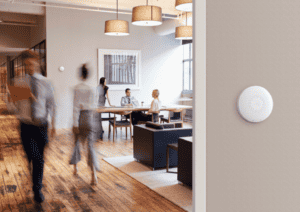Over the past year, healthcare services have been limiting in-person appointments as an infection control measure.
The pandemic has highlighted the need for stronger infection control when it comes to COVID, but also for a range of everyday harmful germs that can be spread. Doctors and hospital waiting rooms can be a breeding ground for microbes. Practice and hospital managers need to take effective measures beyond social distancing to keep both patients and healthcare staff safe.
Guidelines for infection control in healthcare facilities
Pre-covid, it’s likely that your image of a waiting room in a healthcare facility is a busy area at capacity with sick people sitting shoulder to shoulder, coughing and sneezing germs into the air.
Along with the rest of the UK, doctors practices, dentists offices and hospital departments reduced the number of in-person appointments. The majority of non-emergency patients received treatment over the phone, or were placed on a waiting list to reschedule.
Guidelines for infection control in healthcare facilities focused on reducing patient contact both with other patients and healthcare professionals. This included the closure of waiting rooms, asking patients to wait outside the building ahead of their appointment and the introduction of masks and PPE.
However, as the UK begins to open back up and healthcare facilities follow suit, they will need to reassure patients that the risk of catching any germs is minimal. While this can be more controlled inside the doctor’s office for a one-on-one, the waiting room is an issue that needs to be addressed.
Infection control in healthcare
Due to patient expectation and social responsibility, more robust measures will need to be put in place. As a result, healthcare facility leaders are looking for affordable solutions that have an impact.
Staggered appointments
To reduce the risk of patients coming into contact, practices may adopt a staggered in-person appointment system. While this could possibly reduce waiting room time, appointments can run over the scheduled time. This can quickly form a backlog of patients and fill up a waiting room by the end of practice hours.
The system may also see less appointments available to patients. With some patients waiting up to a month for a GP appointment, offering a reduced number of slots could see patients waiting an unacceptable amount of time for a consultation.
Social distancing
Social distancing can reduce the spread of harmful germs. However, it isn’t an adequate long-term solution for a busy and poorly ventilated waiting room. While precautionary measures such as seat spacing have been introduced as a standard in most public settings, air moves around the room. This carries potentially dangerous microbes between patients to inhale.
Long term healthcare infection control solutions
With a full understanding of the dangers of common microbes, healthcare professionals must set the standard. Introducing a robust infection prevention strategy beyond social distancing and PPE should be the norm, especially when dealing with those most at risk. Infection control standards in hospitals and other settings must go beyond guidelines as the potential for breakouts is higher than the average public area.
By fighting and killing harmful microbes as they enter the airspace of the practice, facilities can focus on treating patients instead of contributing to their illness.
Ultraviolet germicidal irradiation (UVGI)
One proven measure adopted by healthcare facilities worldwide is ultraviolet germicidal irradiation, commonly known as UVGI.
UVGI uses short-wavelength ultraviolet (UV-C) light to disinfect indoor air. Proven to be effective against 99.9% of common microbes, it kills almost all unwanted germs in a matter of minutes – just the right amount of time to keep patients safe in a waiting room.
Infection control in dentist and GP offices
With smaller buildings, most dentist and GP practices likely don’t have a mechanical ventilation system to consistently circulate clean air through the building. Standalone units can be fixed to walls and plugged into a standard socket, working silently in the background throughout the day to keep patients safe.
Hospital infection control
Hospitals are huge buildings, with air handling systems carrying the air through the building. If circulated air isn’t cleaned, dangerous air could be being carried from ward to ward. This poses a risk to patients in the entire building.
With a retrofit solution, hospital ventilation systems clean the air as it moves through the vents. This ensures that clean, safe air is circulated throughout the building.
For healthcare managers, cleaning the air within the vents reduces the need for cleaning and maintenance, saving costs in the long term.
To discuss how we can support your healthcare facility in providing safe, clean air to patients and staff, reach out to us at [email protected] for a free consultation.








